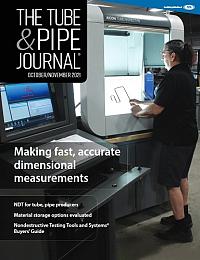Founder
- FMA
- The Fabricator
- FABTECH
- Canadian Metalworking
Categories
- Additive Manufacturing
- Aluminum Welding
- Arc Welding
- Assembly and Joining
- Automation and Robotics
- Bending and Forming
- Consumables
- Cutting and Weld Prep
- Electric Vehicles
- En Español
- Finishing
- Hydroforming
- Laser Cutting
- Laser Welding
- Machining
- Manufacturing Software
- Materials Handling
- Metals/Materials
- Oxyfuel Cutting
- Plasma Cutting
- Power Tools
- Punching and Other Holemaking
- Roll Forming
- Safety
- Sawing
- Shearing
- Shop Management
- Testing and Measuring
- Tube and Pipe Fabrication
- Tube and Pipe Production
- Waterjet Cutting
Industry Directory
Webcasts
Podcasts
FAB 40
Advertise
Subscribe
Account Login
Search
How manufacturers can prepare for the unknowns of 2022
Before casting off into next year, metal fabrication shops need a plan to remain flexible
- By Lisa Wertzbaugher
- November 9, 2021
- Article
- Shop Management

A comprehensive annual plan is essential for a business in an industry as dynamic as metal fabrication. Columnist Lisa Wertzbaugher outlines some of the most necessary components of an annual plan, including the most important one: flexibility. Getty Images
As we close in on the end of 2021, the pandemic is still with us, and we’re still in a state of uncertainty. Many of us were hoping it would be over quickly, perhaps by the end of 2020. Well, we’re not there yet, and the one thing we know going into 2022 is that many unknowns are still out there. This isn’t what anyone wants to hear, but I encourage you—do not be daunted. I have a pragmatic approach to running a business, so despite instability and new hurdles, I stick to the same overarching strategy. If the winds change, I adjust my sails accordingly. Analyze, plan, execute, measure, and adjust. It’s not necessarily simple, but it is basic.
This is the time of year most of you should be tackling annual analysis and planning activities, especially if your fiscal year tracks the calendar year. Then, when 2022 comes around, you are ready to execute, measure successes, and adjust throughout the year. Let’s review a basic strategy.
Traditional Planning Exercises
These are the standards, and what I consider bare minimum: sales projections, budgeting, and an update of the strategic plan. I’m a salesperson by trade, so I like to start with projections. It also helps when setting a budget to know how much money you will be working with. The sales lead is responsible for building projections with the sales team, and each department should prepare a budget to roll up into an overall company plan. These exercises should be executed in late Q3 and early Q4. Toward the end of the year, the leadership team should set aside time for strategic planning to update company goals and strategies and set priorities for the next year.Build Your Calendar and Travel Plan
Will we be traveling in 2022? Yes. Many businesses already have resumed customer visits and tradeshow attendance. Travel schedules might not be at pre-COVID-19 levels, but salespeople should plan to take some trips.
Review the conference schedule for your industry and select events to attend. Communicate with your accounts about vendor visit policies and create a schedule to see the customers that have opened their doors.
I already have the FMA Annual Meeting in Miami (March 1-3) and the Pipe & Tube Memphis 2022 (April 11-13) on my schedule, and I hope to see you there!
Develop a Virtual Strategy
COVID-19 will continue to impact our daily lives and businesses. Depending on the geographic location of your customers and certain conferences, virtual engagement will be necessary. As we’ve seen in 2021, countries, regions, states, and businesses will have varying policies around COVID-19 mitigation and customer/vendor interaction.
Evaluate platforms and channels for virtual meetings, identify trainings and webinars to attend, and register for virtual conferences that make sense for your businesses. In a worst-case scenario, you spend some time developing this strategy and never need to use it. You’ve lost a little time, but it’s better to be prepared.
Beef up Your Social Media Presence
Social media is the marketing strategy that has changed most significantly in the past 18 months. It is time to get on the train. Actually, the train has left the station, but there’s still time to jump the last car. The effects of the pandemic—working at home, shutdown of activities, no travel—gave individuals ample time in front of screens. Social media exploded, and most businesses are engaging in some form.
If you have minimal or no strategy in this area, I highly suggest spending a significant chunk of time on social media planning for 2022. In my consulting business, this is the number one request for support right now. It’s not just for celebrities and entertainers anymore. Manufacturers can (and should) be influencers.
Sourcing
I would be remiss to omit sourcing from the list. Whether it’s raw material or finished product supply, logistics, or hiring buyers and planners, sourcing is the largest bottleneck for many U.S. companies right now. If you import from Asia, assume increased lead times and delays until mid-summer 2022 at a minimum.
The trucking industry was overwhelmed by the pandemic, with no slowdown in sight. Vet freight partners and find additional resources for next year. Consider price increases (when and how much), because you will be receiving them if you aren’t already.
Workforce Management
We all continually struggle with workforce development—it has no season. At a minimum, review your current partners—recruiters, staffing agencies, human resources—and make sure you have the right team in place to help you build yours.
About the Author

About the Publication
Related Companies
subscribe now

The Tube and Pipe Journal became the first magazine dedicated to serving the metal tube and pipe industry in 1990. Today, it remains the only North American publication devoted to this industry, and it has become the most trusted source of information for tube and pipe professionals.
start your free subscription- Stay connected from anywhere

Easily access valuable industry resources now with full access to the digital edition of The Fabricator.

Easily access valuable industry resources now with full access to the digital edition of The Welder.

Easily access valuable industry resources now with full access to the digital edition of The Tube and Pipe Journal.
- Podcasting
- Podcast:
- The Fabricator Podcast
- Published:
- 04/16/2024
- Running Time:
- 63:29
In this episode of The Fabricator Podcast, Caleb Chamberlain, co-founder and CEO of OSH Cut, discusses his company’s...
- Trending Articles
Team Industries names director of advanced technology and manufacturing

Orbital tube welding webinar to be held April 23

Zekelman Industries to invest $120 million in Arkansas expansion

Push-feeding saw station cuts nonferrous metals

3D laser tube cutting system available in 3, 4, or 5 kW

- Industry Events
16th Annual Safety Conference
- April 30 - May 1, 2024
- Elgin,
Pipe and Tube Conference
- May 21 - 22, 2024
- Omaha, NE
World-Class Roll Forming Workshop
- June 5 - 6, 2024
- Louisville, KY
Advanced Laser Application Workshop
- June 25 - 27, 2024
- Novi, MI


























